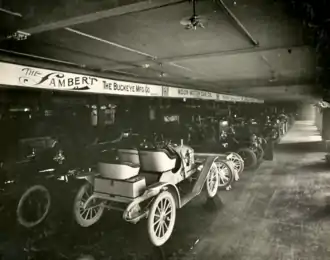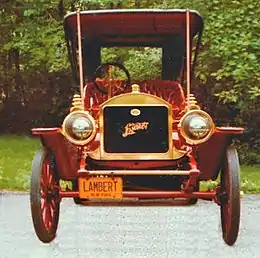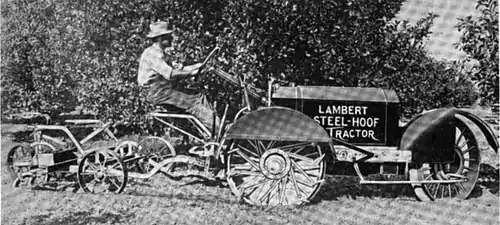Lambert Automobile Company
The Lambert Automobile Company developed as a 300,000-square-foot (28,000 m2) automobile factory in Anderson, Indiana. It manufactured the Lambert automobile, truck, fire engine and farm tractor through the governing Buckeye Manufacturing Company. Production of vehicles manufactured by the company had been from 1905-1915. In 1910 the company had over a thousand employees and from 1910 to 1915 the production had reached about three thousand vehicles per year. It went out of business in 1917 because of World War I.
 | |
 | |
| Type | Automobile Manufacturing |
|---|---|
| Industry | Automotive |
| Founded | 1905 |
| Founder | John William Lambert |
| Defunct | 1916 |
| Headquarters | , |
Area served | United States |
| Products | Vehicles Automotive parts |

History
The Lambert Automobile Company materialized as the second factory plant for the Union Automobile Company of Union City, Indiana. This factory plant was built in Anderson, Indiana, in 1904 and had 300,000 square feet (28,000 m2) of factory floor space.[1] The name changed officially in 1905 to the Lambert Automobile Company and the Union Automobile Company name was dropped. A better quality automobile was then manufactured from the Union automobile.[2]
The Lambert Automobile Company came about by automotive pioneer John William Lambert. The company based in Anderson was managed by Lambert's father George A. Lambert.[3] The Lambert Automobile Company manufactured the Lambert automobile and other vehicles under the supervision of the Buckeye Manufacturing Company which had several subsidiaries. In the eleven years from 1905 through 1916 the company manufactured not only automobiles but trucks, fire engines and farm tractors.[4][5]
The Lambert automobile was the signature product of the company. One of the main features of the Lambert automobile was the friction gearing disk drive transmission.[6][7][8] The company always made their own bodies, but sometimes had the engines manufactured by different independent motor builders. These outsourced motors done by manufacturers like Buda Engine Company, Rutenber Motor Company, Continental Motors Company, Trebert Gas Engine Company, and Davis Motor Car Company were always of Lambert's design. The upholstery used on the interiors was of the best quality obtainable and the final body finish was done with fifteen coats of enamel paint.[9]
In 1906 Lambert made the inaugural "Lambert" automobile. With this line Lambert established himself as a prosperous automobile manufacturer of that time period. Most of his automobiles were chain-driven rather than shaft driven. Production of automobiles and trucks had reached two thousand vehicles per year from 1906 to 1910. In 1910 the company had over a thousand employees and from 1910 to 1915 the production had reached about three thousand vehicles per year.[9] It only produced about one thousand vehicles in 1916 and only a few vehicles in 1917.[10]
Lambert Steel Hoof Tractor
The Lambert Steel Hoof Tractor was introduced to the farm industry in 1912 by Buckeye Manufacturing Company as a product of the Lambert Automobile Company.[11][12] It performed work that ten horses did before and could turn in an eleven foot circle.[13] It was a three-wheeled or four-wheeled gasoline engine farm tractor equipped with solid rubber tires and steel wheels. It had a drive-wheel design with retractable pads.[11] At this time B. F. Lambert, brother of Lambert, was president of the Lambert Tractor Company, president of the Buckeye Manufacturing Company, and president of Lambert Gas and Gasoline Engine Company. Lambert's other brother, A. L. Lambert, was also associated with these companies and was general sales manager of the Lambert Automobile Company. All these companies were working together in Anderson at the same time.[14]
The Lambert Steel Hoof Tractor was sometimes referred to as an automobile tractor and one of its purposes was for the cultivating of fruit orchards.[15] The hoof tractor received its name because of the fact that the wheels are equipped with steel cleats which engage loose dirt much the same way as the hoofs of a horse.[12] The vehicle converted automatically from a farm tractor for cultivation into a hauling truck.[16] With attachments it became an irrigation pump, sawmill, hay baler and crop cutter for making silage.[17] In one advertisement that came out in 1913 it said that in an orchard of the Leffingwell Rancho in Whittier, California, the Lambert farm tractor cultivated a thirty acre lemon grove six inches deep in adobe soil at the rate of two acres per hour on a fuel consumption of less than a gallon of gasoline per acre.[18]
- Model X Specifications

- Mechanical service – 10–20 horsepower
- Bore – 4.5 inches
- Stroke – 5 inches
- Tires Front – 42 x 3 inches
- Tires Rear – 42 x 3.5 inches
- Frame – Channel steel 5 inches
- Rear Axle – Square forging
- Carburetor – Schebler
- Cooling System – Water with large centrifugal pump
- Ignition – Briggs dual
- Control – On top of steering post
- Transmission – Three speeds forward and three reverse
- Steering Gear – Double nut
Demise
When the United States entered into World War I the Lambert Automobile Company factory plant was converted for national defense products. The company then made weapon products and military equipment. When the war ended in 1918 Lambert decided not to resume automobile production and only made parts for automobiles by means of the Buckeye Manufacturing Company.[4] Lambert realized automobiles were only going to be made by large automobile manufactures. The Buckeye Manufacturing Company stopped manufacturing automobile parts permanently in 1922.[19] There are four Lambert automobiles known to have survived that are held privately.[20]
See also
| Wikimedia Commons has media related to Lambert Automobile Company. |
Notes
- "Union Automobile Company". The Antique Automobile. 24–25: 344. 1960.
- Dolnar, pp. 225–228
- "Rich Anderson Man Decorates Home to Receive Little Ones". The Indianapolis Star. Indianapolis, Indiana. December 26, 1906. p. 5 – via Newspapers.com
 .
. - Kimes 1996, p. 835.
- Georgano 2000, p. 1642.
- The Horseless Age: The Automobile Trade Magazine, p. 127
- Anderson Sunday Herald; Anderson, Indiana; November 16, 1958
- Brandon, p. 180
- Lucendo 2019, p. 1864.
- Anthony Harrigan (December 23, 1976). "Enterprise Story". The Columbus Telegram. Columbus, Nebraska. p. 4 – via Newspapers.com
 .
. - Wendel 2005, p. 1.
- "Lambert's Steel Hoof Tractor". Motor Age. 22: 33. 1912.
- "Lambert Steel Hoof Tractor". Motor Trucks of America. 2: 33. 1913.
- "Elwood Iron Works". The Call-Leader. Elwood, Indiana. October 17, 1914. p. 27 – via Newspapers.com
 .
. - "Auto Tractor for Orchards will be made in this City". Los Angeles Evening Post-Record. Los Angeles, California. April 20, 1912. p. 3 – via Newspapers.com
 .
. - "Adios, Patient Ranch Horse! This Tractor Dethrones you". Los Angeles Herald. Los Angeles, California. July 12, 1913. p. 21.
- "Lambert Tractor Does The Work of Ten Horses". The San Bernardino Sun. San Bernardino, California. August 26, 1913. p. 2 – via Newspapers.com
 .
. - "Lambert Steel Hoof Tractor". Tractor and Gas Engine Review. 6 (9): 344. 1913.
- Naldrett 2016, p. 73.
- David Humphrey (September 14, 2013). "Several auto factories in the city before the Remy brothers". The Herald Bulletin. Anderson, Indiana.
Sources
- Georgano, G.N. (2000). The Beaulieu Encyclopedia of the Automobile. Taylor & Francis. ISBN 1-57958-293-1.
- Kimes, Beverly Rae (1996). Standard Catalog of American Cars, 1805–1942. Krause Publications. ISBN 0-87341-428-4.
- Lucendo, Jorge (2019). Cars of Legend. Jorge Lucendo Publications.
- Naldrett, Alan (2016). Lost Car Companies of Detroit. Arcadia. ISBN 9781625856494.
- Wendel, C.H. (2005). Standard Catalog of Farm Tractors 1890-1980. Penguin. ISBN 9781440225680.
Further reading
- Biography of John W. Lambert, written by his son January 25, 1935 — obtained from the Detroit Public Library, National Automotive History Collection
- Dolnar, Hugh, Automobile Trade Journal, article: The Lambert, 1906 Line of Automobiles, Chilton Company, v.10 January 1906
- Forkner, John L., History of Madison County, Indiana, New York and Chicago, The Lewis Publishing Company, 1914
- The Horseless Age: The Automobile Trade Magazine, The Horseless Age Company, 1902
- Bailey, L. Scott, Historic Discovery: 1891 Lambert, New Claim for America's First Car, Antique Automobile magazine, Vol. 24, No. 5, Oct–Nov 1960
- David Burgess Wise, The New Illustrated Encyclopedia of Automobiles ISBN 0-7858-1106-0
- Dittlinger, Esther et al., Anderson: A Pictorial History, G. Bradley Publishing, 1990, ISBN 0-943963-16-8
- Huffman, Wallace Spencer, Indiana's Place in Automobile History in Indiana History Bulletin, vol 44, no. 2, Feb. 1967; Indianapolis, Indiana Historical Bureau
- Huhti, Thomas, The Great Indiana Touring Book: 20 Spectacular Auto Tours, Big Earth Publishing, 2002, ISBN 1-931599-09-2
- James, Wanda, Driving from Japan, McFarland, 2005, ISBN 0-7864-1734-X
- Madden, W. C., Haynes-Apperson and America's First Practical Automobile: A History, McFarland, 2003, ISBN 0-7864-1397-2
- Scharchburg, Richard P., Carriages Without Horses: J. Frank Duryea and the Birth of the American Automobile Industry, SAE, 1993, ISBN 1-56091-380-0